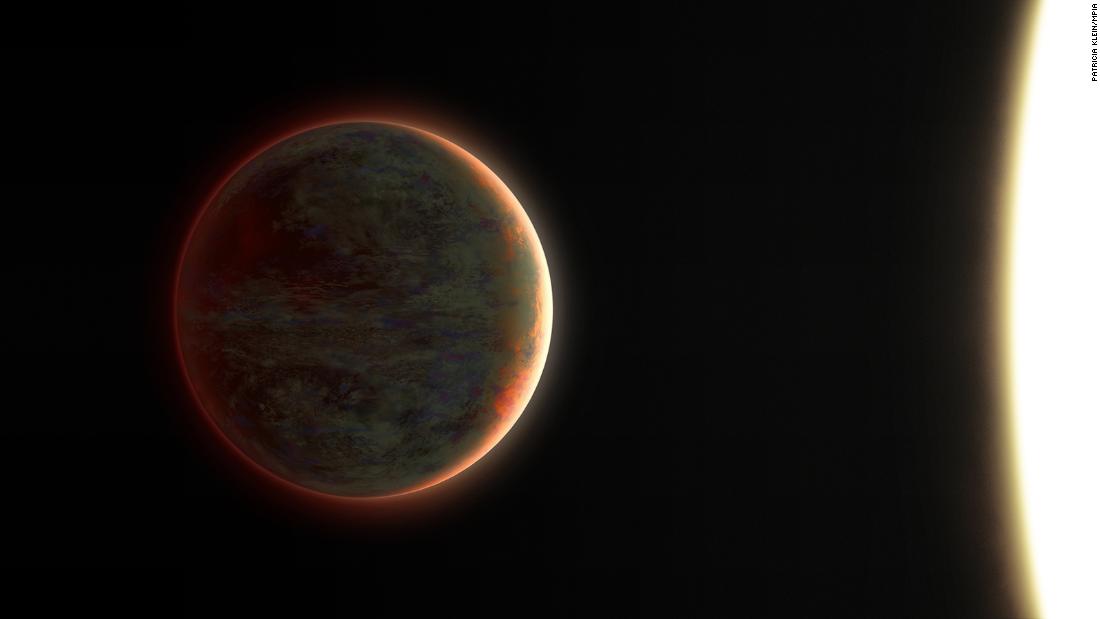
Sign up for CNN's Wonder Theory science newsletter. Explore the universe with news on fascinating discoveries, scientific advancements and more.
(CNN)The weather on this piping hot exoplanet is truly out of this world.
A massive gas giant orbiting a star about 855 light-years from Earth, WASP-121b may have metal clouds and rain made of liquid gems, according to new research.
A study showing how water atmospherically cycles between the planet's two sides published Monday in the journal Nature Astronomy.
The planet, first discovered in 2015, is considered to be an ultrahot Jupiter-like planet because it's hotter and has a greater mass and diameter than the largest planet in our solar system.
Since then, researchers have made discoveries that show WASP-121b only gets stranger the more they learn.
The exoplanet has a glowing water vapor atmosphere and is being deformed into the shape of a football due to the intense gravitational pull of the star it orbits.
Every 30 hours, WASP-121b completes one orbit and is tidally locked, much like the moon is to Earth. That means one side of the planet, the dayside, always faces the star. The other side experiences a permanent night that faces space.
"Hot Jupiters are famous for having very bright day sides, but the night side is a different beast. WASP-121b's night side is about 10 times fainter than its day side," said study coauthor Tansu Daylan, postdoctoral research fellow in astrophysics at the Massachusetts Institute of Technology, in a statement.
Now, astronomers have studied both sides of the planet to better understand its atmosphere and alien weather using the Hubble Space Telescope.
Extreme water cycle
On Earth, water evaporates and its vapor condenses into clouds, which then release rain. On WASP-121b, water goes through a more vicious cycle.
The water atoms are ripped apart by the blazing hot temperatures experienced by the planet on the dayside. These atoms are carried over to the nightside by winds that reach more than 11,000 miles per hour (17,703 kilometers per hour). There, the molecules come together once more to form water before being shoved over to the dayside again.
"These winds are much faster than our jet stream, and can probably move clouds across the entire planet in about 20 hours," Daylan said. He previously studied the planet using data from NASA's Transiting Exoplanet Survey Satellite mission.
The temperature differences between the two sides of the planet also mean that the nightside is cool enough for metal clouds made of iron and corundum to form. Corundum is a mineral found in rubies and sapphires.
Much like water vapor that gets cycled around on WASP-121b, these metal clouds may get shoved over to the dayside where the metals vaporize into gases. But before the clouds leave the nightside, they could release rain made of liquid gems.
"With this observation, we're really getting a global view of an exoplanet's meteorology," said lead study author Thomas Mikal-Evans, research group leader at the Max Planck Institute for Astronomy in Germany.
"Despite the discovery of thousands of exoplanets, we've only been able to study the atmospheres of a small fraction due to the challenging nature of the observations," he said. "We're now moving beyond taking isolated snapshots of specific regions of exoplanet atmospheres, to study them as the 3D systems they truly are."
Mikal-Evans led the study while he was a postdoctoral student at the Massachusetts Institute of Technology's Kavli Institute for Astrophysics and Space Research.
Extraterrestrial weather
The findings also reveal the dramatic differences in temperature between day and night on the planet, which the team determined by tracking the water cycle on WASP-121b.
On the dayside, temperatures begin at 4,040 degrees Fahrenheit (2,227 degrees Celsius) at the deepest layer of the atmosphere and reach 5,840 degrees Fahrenheit (3,227 degrees Celsius) at the top layer. On the nightside, things are cooler and reversed, with the warmest temperature being 2,780 degrees Fahrenheit (1,527 degrees Celsius) and dropping to 2,240 degrees Fahrenheit (1,227 degrees Celsius) in the upper atmosphere.
The astronomers will observe WASP-121b later this year using the James Webb Space Telescope.
"It's exciting to study planets like WASP-121 b that are very different to those in our Solar System, because they allow us to see how atmospheres behave under extreme conditions," said study coauthor Joanna Barstow, research fellow at The Open University in the United Kingdom, in a statement.
Science - Latest - Google News
February 22, 2022 at 12:53AM
https://ift.tt/MFIZSGt
The weather on this exoplanet includes metal clouds and rain made of precious gems - CNN
Science - Latest - Google News
https://ift.tt/GaKyh6q
https://ift.tt/QqwTvSa
Bagikan Berita Ini

















0 Response to "The weather on this exoplanet includes metal clouds and rain made of precious gems - CNN"
Post a Comment